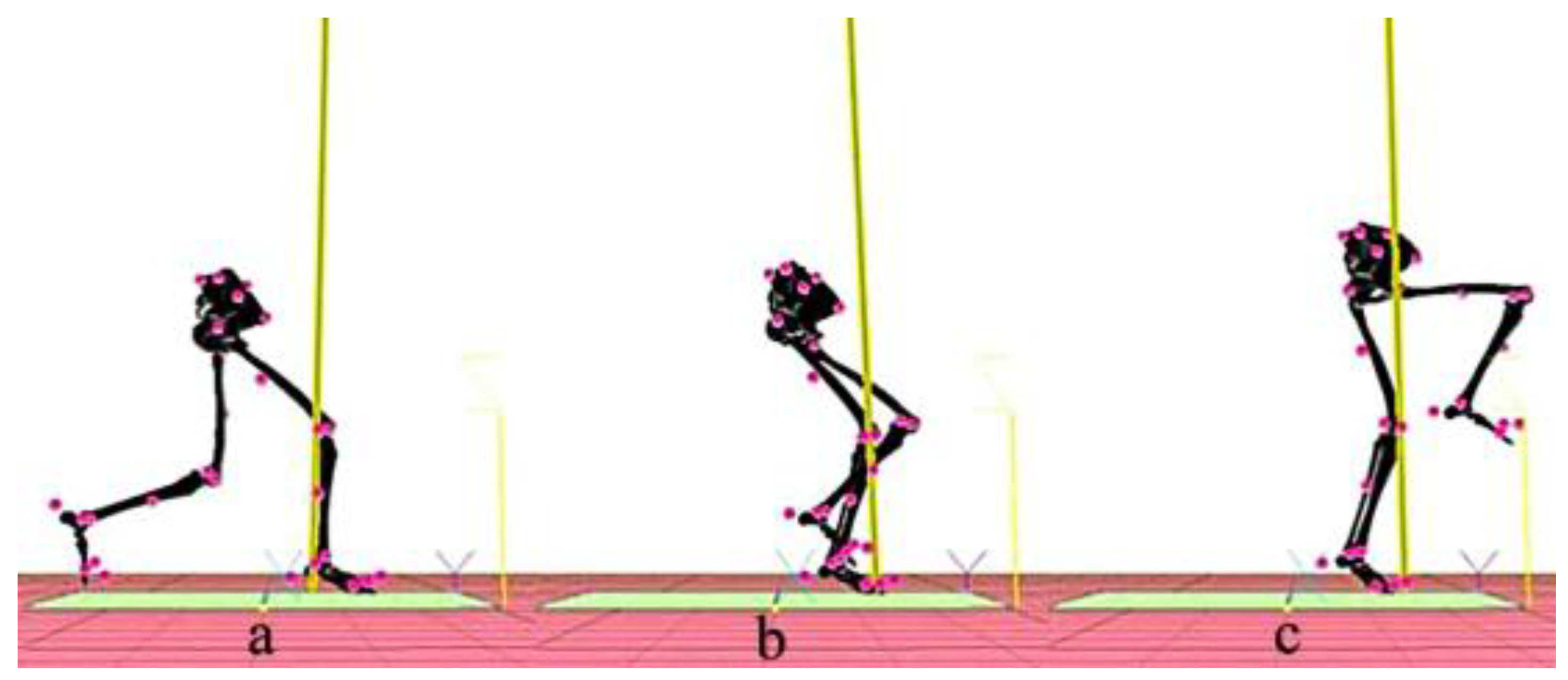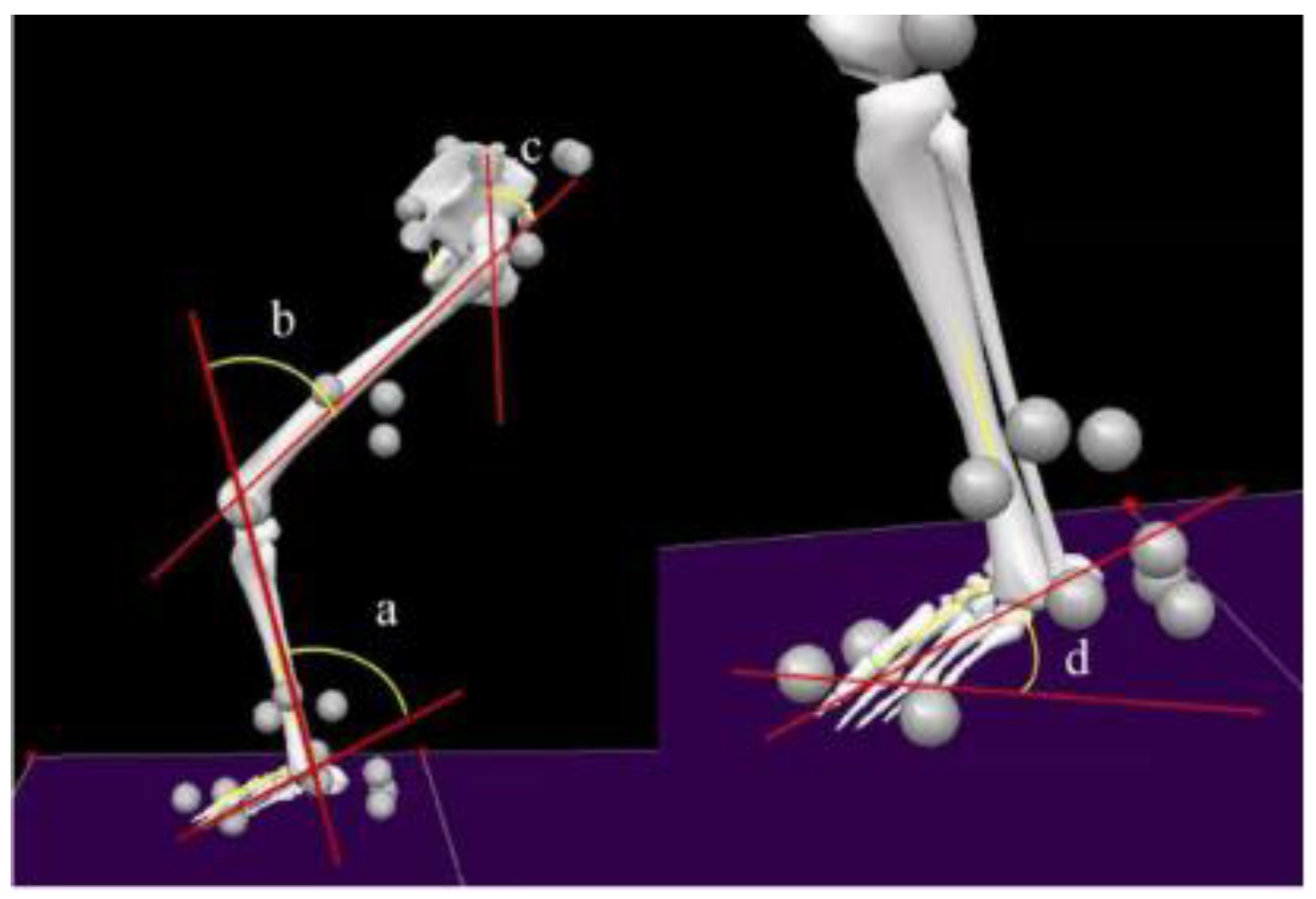Acute Effects of Midsole Bending Stiffness on Lower Extremity Biomechanics during Layup Jumps
Abstract
:1. Introduction
2. Methods
2.1. Participants
2.2. Instrumentation
2.2.1. 3D Motion Capture System
2.2.2. 3D Force Plates
2.3. Experimental Protocol
2.3.1. Testing Procedure
2.3.2. Testing Shoes
2.3.3. Marker Setup
2.4. Data Analysis
2.4.1. Sagittal Plane Kinematics
2.4.2. Joint Kinetics
2.4.3. Joint Energy
2.5. Statistics
3. Results
3.1. Performance
3.2. Kinematics and Kinetics of the MTP Joints
3.3. Kinematics and Kinetics of the Hip, Knee and Ankle Joints
4. Discussion
4.1. Performance
4.2. Biomechanics of the MTP Joints
4.3. Biomechanics of the Ankle Joint
4.4. Limitations
5. Conclusions
Author Contributions
Funding
Conflicts of Interest
References
- Sanders, G.J.; Boos, B.; Rhodes, J.; Kollock, R.O.; Peacock, C.A.; Scheadler, C.M. Factors associated with minimal changes in countermovement jump performance throughout a competitive division I collegiate basketball season. J. Sport. Sci. 2019, 37, 2236–2242. [Google Scholar] [CrossRef] [PubMed]
- Ciacci, S.; Bartolomei, S. The effects of two different explosive strength training programs on vertical jump performance in basketball. J. Sport. Med. Phys. Fit. 2018, 58, 1375–1382. [Google Scholar] [CrossRef]
- Stevanovic, V.B.; Jelic, M.B.; Milanovic, S.D.; Filipovic, S.R.; Mikic, M.J.; Stojanovic, M.D.M. Sport-Specific Warm-Up Attenuates Static Stretching-Induced Negative Effects on Vertical Jump but not Neuromuscular Excitability in Basketball Players. J. Sport. Sci. Med. 2019, 18, 282–289. [Google Scholar]
- Yuksel, O.; Erzeybek, M.S.; Kaya, F.; Akin, S.; Kirazci, S. The Effect of Eccentric Strength and Depth Jump Training on Strength, Vertical Jump, and Modified Y Balance on Male Basketball Players. Int. J. Appl. Exerc. Physiol. 2019, 8, 313–320. [Google Scholar]
- Vint, P.F.; Hinrichs, R.N. Differences between one-foot and two-foot vertical jump performances. J. Appl. Biomech. 1996, 12, 338–358. [Google Scholar] [CrossRef]
- Young, W.; Wilson, G.; Byrne, C. Relationship between strength qualities and performance in standing and run-up vertical jumps. J. Sport. Med. Phys. Fit. 1999, 39, 285–293. [Google Scholar]
- Roca-Dols, A.; Elena Losa-Iglesias, M.; Sanchez-Gomez, R.; Becerro-de-Bengoa-Vallejo, R.; Lopez-Lopez, D.; Rodriguez-Sanz, D.; Maria Martinez-Jimenez, E.; Calvo-Lobo, C. Effect of the cushioning running shoes in ground contact time of phases of gait. J. Mech. Behav. Biomed. Mater. 2018, 88, 196–200. [Google Scholar] [CrossRef]
- Yang, Y.; Fang, Y.; Zhang, X.N.; He, J.L.; Fu, W.J. Does Shoe Collar Height Influence Ankle Joint Kinematics and Kinetics in Sagittal Plane Maneuvers? J. Sport. Sci. Med. 2017, 16, 543–550. [Google Scholar]
- De Bengoa Vallejo, R.B.; Sanchez Gomez, R.; Losa Iglesias, M.E. Clinical improvement in functional hallux limitus using a cut-out orthosis. Prosthet. Orthot. Int. 2016, 40, 215–223. [Google Scholar] [CrossRef]
- Stefanyshyn, D.J.; Nigg, B.M. Mechanical energy contribution of the metatarsophalangeal joint to running and sprinting. J. Biomech. 1997, 30, 1081–1085. [Google Scholar] [CrossRef]
- Willwacher, S.; Koenig, M.; Potthast, W.; Brueggemann, G.-P. Does Specific Footwear Facilitate Energy Storage and Return at the Metatarsophalangeal Joint in Running? J. Appl. Biomech. 2013, 29, 583–592. [Google Scholar] [CrossRef] [Green Version]
- Oh, K.; Park, S. The bending stiffness of shoes is beneficial to running energetics if it does not disturb the natural MTP joint flexion. J. Biomech. 2017, 53, 127–135. [Google Scholar] [CrossRef] [PubMed]
- Tinoco, N.; Bourgit, D.; Morin, J.B. Influence of midsole metatarsophalangeal stiffness on jumping and cutting movement abilities. Proc. Inst. Mech. Eng. Part P J. Sport. Eng. Technol. 2010, 224, 209–217. [Google Scholar] [CrossRef]
- Lam, W.K.; Lee, W.C.C.; Lee, W.M.; Ma, C.Z.H.; Kong, P.W. Segmented Forefoot Plate in Basketball Footwear: Does it Influence Performance and Foot Joint Kinematics and Kinetics? J. Appl. Biomech. 2018, 34, 31–38. [Google Scholar] [CrossRef] [PubMed] [Green Version]
- Worobets, J.; Wannop, J.W. Influence of basketball shoe mass, outsole traction, and forefoot bending stiffness on three athletic movements. Sport. Biomech. 2015, 14, 351–360. [Google Scholar] [CrossRef] [PubMed]
- Quammen, D.; Cortes, N.; Lunen, V.; Bonnie, L.; Lucci, S.; Ringleb, S.I. Two different fatigue protocols and lower extremity motion patterns during a stop-jump task. J. Athl. Train. 2011, 47, 32–41. [Google Scholar] [CrossRef] [PubMed] [Green Version]
- Fu, W.; Fang, Y.; Gu, Y.; Huang, L.; Li, L.; Liu, Y. Shoe cushioning reduces impact and muscle activation during landings from unexpected, but not self-initiated, drops. J. Sci. Med. Sport 2017, 20, 915. [Google Scholar] [CrossRef] [PubMed]
- Roy, J.P.; Stefanyshyn, D.J. Shoe midsole longitudinal bending stiffness and running economy, joint energy, and EMG. Med. Sci. Sport. Exerc. 2006, 38, 562–569. [Google Scholar] [CrossRef] [Green Version]
- Horita, T.; Komi, P.; Nicol, C.; Kyröläinen, H. Interaction between pre-landing activities and stiffness regulation of the knee joint musculoskeletal system in the drop jump: Implications to performance. Eur. J. Appl. Physiol. 2002, 88, 76–84. [Google Scholar] [CrossRef]
- Zhang, S.J.; Wortley, M.; Silvernail, J.F.; Carson, D.; Paquette, M. Do ankle braces provide similar effects on ankle biomechanical variables in subjects with and without chronic ankle instability during landing? J. Sport Health Sci. 2012, 1, 114–120. [Google Scholar] [CrossRef] [Green Version]
- Bosco, C.; Luhtanen, P.; Komi, P.V. A simple method for measurement of mechanical power in jumping. Eur. J. Appl. Physiol. Occup. Physiol. 1983, 50, 273–282. [Google Scholar] [CrossRef] [PubMed]
- Stefanyshyn, D.J.; Nigg, B.M. Influence of midsole bending stiffness on joint energy and jump height performance. Med. Sci. Sport. Exerc. 2000, 32, 471. [Google Scholar] [CrossRef] [PubMed] [Green Version]
- Stefanyshyn, D.J.; Nigg, B.M. Contribution of the lower extremity joints to mechanical energy in running vertical jumps and running long jumps. J. Sport. Sci. 1998, 16, 177–186. [Google Scholar] [CrossRef] [PubMed]
- Smith, G.; Lake, M.; Lees, A.; Worsfold, P. Measurement procedures affect the interpretation of metatarsophalangeal joint function during accelerated sprinting. J. Sport. Sci. 2012, 30, 1521–1527. [Google Scholar] [CrossRef] [Green Version]
- Wunsch, T.; Alexander, N.; Kroll, J.; Stoggl, T.; Schwameder, H. Effects of a leaf spring structured midsole on joint mechanics and lower limb muscle forces in running. PLoS ONE 2017, 12. [Google Scholar] [CrossRef]
- Willwacher, S.; Koenig, M.; Braunstein, B.; Goldmann, J.-P.; Brueggemann, G.-P. The gearing function of running shoe longitudinal bending stiffness. Gait Posture 2014, 40, 386–390. [Google Scholar] [CrossRef]
- Hoogkamer, W.; Kipp, S.; Kram, R. The Biomechanics of Competitive Male Runners in Three Marathon Racing Shoes: A Randomized Crossover Study. Sport. Med. 2019, 49, 133–143. [Google Scholar] [CrossRef]
- Willwacher, S.; Kurz, M.; Menne, C.; Schrodter, E.; Bruggemann, G.P. Biomechanical response to altered footwear longitudinal bending stiffness in the early acceleration phase of sprinting. Footwear Sci. 2016, 8, 99–108. [Google Scholar] [CrossRef]



| Shoe Condition | Jump Height (cm) | Effect Size | P |
|---|---|---|---|
| SS | 66.3 (6.9) | 0.043 | 0.234 |
| CS | 66.0 (7.0) |
| Variables | SS | CS | Effect Size | P |
|---|---|---|---|---|
| Max. angle (°) | 31.2 (9.8) | 29.7 (5.2) | 0.191 | 0.266 |
| Min. angle (°) | 23.3 (8.6) | 22.2 (4.9) | 0.157 | 0.82 |
| θROM (°) | 7.9 (2.2) | 7.5 (2.4) | 0.174 | 0.064 |
| Max. angular velocity (°/s) | 78.3 (22.4) | 87.1 (25.7) | 0.365 | 0.636 |
| Min. angular velocity (°/s) * | −56.4 (31.2) | −69.1 (25.6) | 0.445 | 0.032 |
| Max. torque (N·M) | 75.4 (23.8) | 73.0 (21.4) | 0.106 | 0.691 |
| Min. power (W) | −117.8 (57.6) | −86.0 (77.9) | 0.464 | 0.764 |
| Max. power (W) | 69.0 (29.0) | 67.2 (65.3) | 0.035 | 0.126 |
| EA (J) | −6.7 (4.6) | −4.7 (4.8) | 0.425 | 0.724 |
| EG (J) | 1.9 (0.9) | 2.0 (2.9) | 0.047 | 0.055 |
| Net energy (J) | −4.8 (3.9) | −2.7 (4.2) | 0.518 | 0.113 |
| Joint | Variables | SS | CS | Effect Size | P |
|---|---|---|---|---|---|
| Hip | Max. angle (°) | 71.3 (10.2) | 71.7 (10.0) | 0.039 | 0.885 |
| Min. angle (°) | 11.9 (7.2) | 14.2 (8.1) | 0.300 | 0.262 | |
| θROM (°) | 59.4 (8.6) | 57.5 (8.6) | 0.221 | 0.406 | |
| Max. angular velocity (°/s) | 87.9 (69.8) | 87.4 (55.9) | 0.008 | 0.971 | |
| Knee | Max. angle (°) | 55.0 (6.7) | 53.6 (5.7) | 0.225 | 0.394 |
| Min. angle (°) | 10.5 (5.6) | 11.0 (5.1) | 0.093 | 0.698 | |
| θROM (°) | 44.5 (6.2) | 42.65 (5.4) | 0.318 | 0.204 | |
| Max. angular velocity (°/s) | 65.6 (50.9) | 68.0 (65.4) | 0.041 | 0.823 | |
| Ankle | Max. angle (°) | 10.8 (6.5) | 10.0 (7.9) | 0.110 | 0.226 |
| Min. angle (°) | −19.7 (8.8) | −19.7 (8.8) | 0.000 | 0.804 | |
| θROM (°) * | 30.8 (6.2) | 29.5 (5.9) | 0.215 | 0.013 | |
| Max. angular velocity (°/s) | 245.0 (108.2) | 245.0 (94.3) | 0.000 | 1.000 |
| Joint | Variables | SS | CS | Effect Size | P |
|---|---|---|---|---|---|
| Hip | Max. torque (N·m) | 98.4 (32.8) | 94.5 (31.7) | 0.121 | 0.729 |
| Min. torque (N·m) | −612.7 (162.1) | −613.1(151.4) | 0.003 | 0.994 | |
| Min. power (W) | |||||
| Max. power (W) | 1379.7 (776.3) | 1551.4 (765.4) | 0.223 | 0.407 | |
| EA (J) | 21.8 (15.2) | 18.5 (12.4) | 0.238 | 0.495 | |
| EG (J) | 93.6 (25.6) | 100.9 (27.5) | 0.275 | 0.484 | |
| Net energy (J) | 71.8 (33.9) | 82.4 (35.2) | 0.307 | 0.447 | |
| Knee | Max. torque (N·m) | 273.1 (44.7) | 266.3 (38.1) | 0.164 | 0.515 |
| Min. torque (N·m) | −150.1 (56.5) | −156.0 (61.7) | 0.100 | 0.756 | |
| Min. power (W) | −552.5 (209.5) | −564.1 (169.2) | 0.061 | 0.861 | |
| Max. power (W) | 1261.4 (305.1) | 1211.1 (265.9) | 0.176 | 0.492 | |
| EA (J) | 38.5 (13.5) | 35.5 (13.6) | 0.221 | 0.445 | |
| EG (J) | 78.9 (27.1) | 71.4 (28.1) | 0.272 | 0.260 | |
| Net energy (J) | 40.4 (17.6) | 35.9 (25.3) | 0.206 | 0.458 | |
| Ankle | Max. torque (N·m) | 19.7 (12.1) | 19.7 (9.8) | 0.000 | 0.977 |
| Min. torque (N·m) | −301.3 (51.9) | −291.7 (33.5) | 0.220 | 0.365 | |
| Min. power (W) | −557.6 (212.9) | −474.9 (180.5) | 0.419 | 0.122 | |
| Max. power (W) * | 1359.6 (249.7) | 1191.7 (283.9) | 0.628 | 0.033 | |
| EA (J) * | 39.1 (11.5) | 32.4 (10.4) | 0.611 | 0.028 | |
| EG (J) * | 84.5 (18.6) | 70.9 (19.5) | 0.714 | 0.012 | |
| Net energy (J) | 45.4 (19.3) | 38.5 (17.8) | 0.372 | 0.211 | |
© 2020 by the authors. Licensee MDPI, Basel, Switzerland. This article is an open access article distributed under the terms and conditions of the Creative Commons Attribution (CC BY) license (http://creativecommons.org/licenses/by/4.0/).
Share and Cite
Zhu, Z.; Fu, W.; Shao, E.; Li, L.; Song, L.; Wang, W.; Liu, Y. Acute Effects of Midsole Bending Stiffness on Lower Extremity Biomechanics during Layup Jumps. Appl. Sci. 2020, 10, 397. https://doi.org/10.3390/app10010397
Zhu Z, Fu W, Shao E, Li L, Song L, Wang W, Liu Y. Acute Effects of Midsole Bending Stiffness on Lower Extremity Biomechanics during Layup Jumps. Applied Sciences. 2020; 10(1):397. https://doi.org/10.3390/app10010397
Chicago/Turabian StyleZhu, Zhiqiang, Weijie Fu, En Shao, Lu Li, Linjie Song, Wei Wang, and Yu Liu. 2020. "Acute Effects of Midsole Bending Stiffness on Lower Extremity Biomechanics during Layup Jumps" Applied Sciences 10, no. 1: 397. https://doi.org/10.3390/app10010397
APA StyleZhu, Z., Fu, W., Shao, E., Li, L., Song, L., Wang, W., & Liu, Y. (2020). Acute Effects of Midsole Bending Stiffness on Lower Extremity Biomechanics during Layup Jumps. Applied Sciences, 10(1), 397. https://doi.org/10.3390/app10010397




